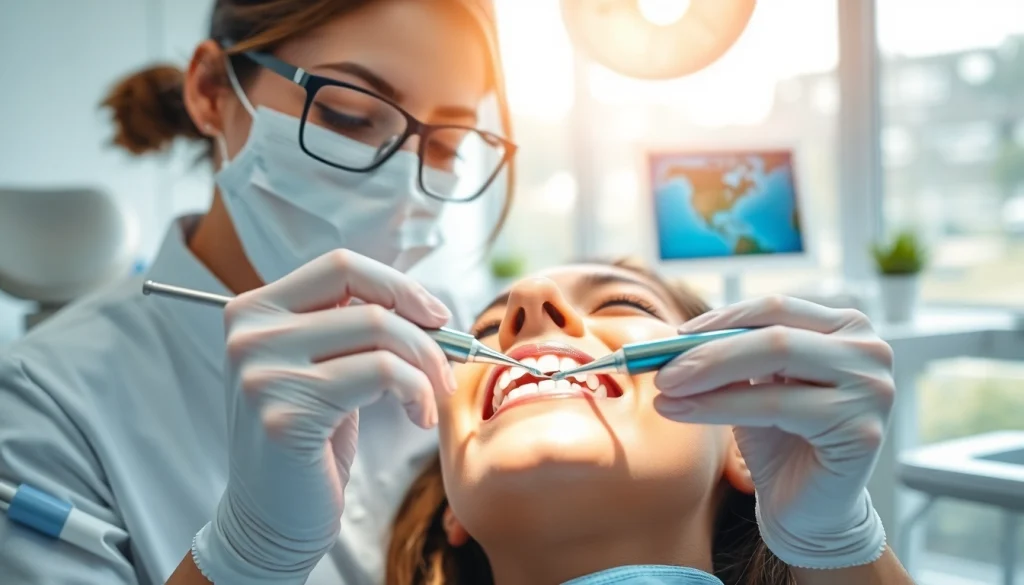Everything You Need to Know About Dental Cleanings for Optimal Oral Health

Understanding Dental Cleanings
Dental cleanings are a crucial component of maintaining oral health. Regular visits to a dentistry professional for dental cleanings help prevent plaque buildup, cavities, and gum disease. These appointments are an opportunity to remove harmful bacteria and tartar that can lead to serious dental issues if not addressed promptly. Understanding what dental cleanings involve, how they benefit you, and the different types available can empower you to take proactive steps toward preserving your oral health.
What Are Dental Cleanings?
A dental cleaning, often referred to as prophylaxis, is a preventative procedure carried out by a dental hygienist or dentist. During this process, professionals utilize specialized tools to clean the teeth, focusing on areas that may be difficult to maintain through regular brushing and flossing alone. The cleaning typically includes several steps:
- Physical Examination: Before the cleaning begins, the hygienist will check the patient’s mouth for any signs of disease or health issues.
- Tartar and Plaque Removal: With an instrument known as a scaler, the hygienist will carefully remove plaque and tartar from the teeth, especially along the gum line and in between the teeth.
- Teeth Polishing: After cleaning, a gritty toothpaste is often used to polish the teeth, helping to remove surface stains and smooth out the enamel.
- Flossing: Finally, thorough flossing is done to ensure that the spaces between the teeth are clear of debris and plaque.
The Importance of Regular Dental Cleanings
Regular dental cleanings should not be viewed merely as a task to check off your to-do list; they are integral to your overall health. These appointments can significantly reduce the risk of developing serious dental conditions, such as periodontal disease (gum disease) and long-term health issues related to oral bacteria. By investing time and effort into your dental cleanings, you’re also investing in your general well-being.
Types of Dental Cleanings
Dental cleanings are not one-size-fits-all; there are different types tailored to individual patient needs. Understanding these can help in choosing the right type of cleaning for your specific circumstances.
Preventive Dental Cleanings
Most adult patients receive preventative dental cleanings, which are typically performed every six months. These appointments focus on maintaining oral hygiene and preventing the onset of decay and gum disease. During preventive cleanings, dental professionals will:
- Clean teeth and polish them.
- Check for early signs of issues such as cavities or gum disease.
- Provide personalized advice on improving at-home hygiene routines.
For children, these cleanings are often accompanied by fluoride treatments to further protect developing teeth.
Deep Cleanings: When and Why
Deep cleanings, or scaling and root planing, are more intensive than regular cleanings and are usually recommended for patients who exhibit signs of gum disease. A deep cleaning involves thoroughly cleaning the roots of the teeth, often requiring local anesthesia and a longer appointment. This approach helps:
- Remove tartar and bacteria below the gum line.
- Promote healing and reduce gum inflammation.
- Prevent tooth loss and contamination of the bloodstream associated with advanced periodontal disease.
If you have not been to the dentist in a while or have been experiencing gum health issues, your dentist may recommend a deep cleaning to restore your oral health.
Specific Techniques Used by Dentists
Dental professionals may employ various techniques during a cleaning session. Some of the more common methods include:
- Ultrasonic Cleaners: These devices use ultrasonic waves to break down tartar and remove plaque effectively. The high-frequency vibrations can reach areas that are otherwise challenging to clean.
- Laser Cleaning: In some practices, lasers are used to clear away tartar and assist in the treatment of gum disease. This minimizes discomfort and can promote faster healing.
- Handheld Instruments: Dental hygienists commonly use scalers, curettes, and other hand tools to meticulously scrape away plaque during standard cleanings.
Benefits of Routine Dental Cleanings
Beyond simply having a bright smile, routine dental cleanings offer numerous benefits that enhance your dental health and overall well-being.
Prevention of Gum Disease
One of the primary benefits of dental cleanings is the prevention of gum disease. This condition begins with gingivitis, characterized by inflammation of the gums, which can progress to periodontitis without proper treatment. Regular cleanings help eliminate bacterial buildup that leads to these conditions, allowing for healthy gums and preventing tooth loss.
Improving Overall Health
Recent studies have suggested a link between oral health and overall health. The bacteria found in the mouth associated with periodontal disease have been connected to other serious health issues such as heart disease and diabetes. By maintaining regular dental cleanings, you not only protect your teeth but also contribute to your body’s overall health.
Contributing to Aesthetic Goals
For many, one of the most visible benefits of routine dental cleanings is improved aesthetics. Cleanings remove stains caused by food, beverages, and tobacco, leading to brighter teeth and better overall oral appearance. This can boost confidence and enhance one’s personal and professional interactions.
FAQs About Dental Cleanings
How Often Should You Have Dental Cleanings?
The general recommendation for most adults is to schedule a dental cleaning every six months. However, individuals with previous dental issues or increased risk factors for gum disease may benefit from more frequent visits.
Do Dental Cleanings Hurt?
While some patients may experience mild discomfort during a dental cleaning, particularly if there is significant tartar buildup or gum sensitivity, most patients find routine cleanings to be relatively painless. In cases where pain is a concern, it is essential to communicate with your dental professional beforehand.
What Happens If You Skip Cleanings?
Neglecting regular dental cleanings can lead to a host of problems, including the buildup of plaque and tartar, development of cavities, and gum disease. Long periods between cleanings increase the likelihood of needing more invasive procedures in the future.
Finding the Right Dental Cleanings for You
Selecting a quality dental professional and understanding your personal oral health needs is crucial for maximizing the benefits of dental cleanings.
Choosing a Qualified Dental Professional
Look for a dental provider who is experienced and comes highly recommended, ideally someone who specializes in preventative care. Checking credentials and reading patient reviews can give insights into the quality of care offered.
Questions to Ask During Your Consultation
When meeting with a potential dental professional, consider asking the following questions:
- What prevention strategies do you recommend for maintaining oral health?
- How do you tailor cleanings based on individual patient needs?
- What are your approaches for managing pain or discomfort during cleanings?
Maximizing the Benefits of Dental Cleanings
To reap the most significant benefits from dental cleanings:
- Maintain a diligent at-home oral hygiene routine.
- Do not delay scheduling an appointment even if you believe your dental health is good; prevention is key.
- Follow any recommendations or advice from your dental provider regarding future care.
By staying proactive, you can ensure the best outcomes for your dental health and overall well-being.







